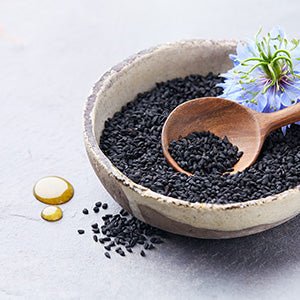What Is the Glycemic Index? Best Low Glycemic Index Foods

The glycemic index (GI) is a way to measure the impact that carbohydrate-containing foods have on blood sugar, or blood glucose.[1] People are interested in understanding the glycemic index (and the glycemic load) of food so they can construct a healthier diet. Blood sugar affects many aspects of health, including the risk of getting cancer, cardiovascular disease, and diabetes, so watching the GI of foods in your diet can improve your overall health prospects.
GI values range from zero to one hundred. The glycemic index was designed to measure how equal amounts of carbohydrates raise blood sugar compared to pure glucose – which is a 100 on the GI scale. Food with a high GI value will make blood sugar levels rise (and fall) quickly, while food with a low GI value has a slow and steady effect on blood sugar.
A GI value under 55 is low. Foods that have a low GI value include beans, cruciferous vegetables, grapefruit, and tomatoes. A GI value between 56-69 is moderate. Moderate GI foods include pasta, green peas, sweet potatoes, orange juice, and blueberries. A GI value over 70 is high.[2] Examples of high GI foods include refined sugar, potatoes, white bread, dried fruit, and watermelon. However, the glycemic index value of foods should be used along with its glycemic load value, explained below, which provides a more accurate understanding of how a single serving will affect your blood sugar.
Food with a high GI value will make blood sugar levels rise (and subsequently fall) quickly, while food with a low GI value has a slow and steady effect on blood sugar.
Factors That Affect Glycemic Index Values
A GI value can be affected by several factors. Processing and refining, for example, will result in a higher GI value for the same food. A whole baked potato has a lower GI value than instant mashed potatoes. Processed orange juice has a higher GI value than fresh squeezed.
Eating different foods together can also affect GI values. Research has shown that when you eat a high fiber diet – particularly soluble fiber – it can counter some negative effects of a high-carbohydrate diet.[3] (Just to ensure there’s no confusion – no, eating a pound of lettuce won’t cancel out eating a pound of sugar.) The riper a fruit or vegetable, the higher its GI value. Also, your physiology, age, metabolism, and health conditions all influence how foods affect blood sugar.
The Relationship Between Types of Carbs & Glycemic Index
Carbohydrates are a primary source of energy for the human body, and there are two basic types: simple carbohydrates and complex carbohydrates.
Simple carbohydrates, chemically known as monosaccharides or disaccharides, are digested quickly and have an immediate effect on blood sugar. Common examples include refined sugar (sucrose) or high fructose corn syrup, as found in soft drinks. In general, foods high in simple carbohydrates have high GI values. Simple carbs cause blood sugar to rise rapidly. When blood sugar rises, the pancreas secretes insulin, which makes cells absorb glucose. As cells absorb the circulating glucose, its level in the blood falls.
Most complex carbohydrates, also known as polysaccharides, are metabolized slowly and do not have such a dramatic effect on blood sugar. Foods high in complex carbohydrates include whole grain bread, vegetables, and legumes. Complex carbohydrates typically have a low GI value and usually provide other nutrients, such as fiber, vitamins, and minerals, that slow digestion time.
Generally, consuming complex carbs results in a more steady level of blood glucose, versus the spike and drop that comes from simple carbs. However, not all complex carbs have a low GI, and it depends on the type of fiber present. Foods high in soluble fiber tend to have lower GI values, but foods with insoluble fiber have higher GI values. Insoluble fiber does not slow down digestion in the way soluble fiber does. The starch in potatoes is also a complex carbohydrate with a high GI value. Starchy foods can act like simple carbs because they are broken down into glucose molecules during digestion.
Interestingly, if you eat a meal with low-GI foods, it lowers your body's blood sugar after eating (postprandial glycemic response) not only for that meal but also for the one after. This is called the second meal effect, and scientists have studied how this influences disease risk for health conditions related to blood sugar.[4]
What Is Glycemic Load?
You might be tempted to avoid all high-GI value foods since high blood sugar is linked with so many health concerns. However, the portion size for each food interacts with and affects blood sugar. You can eat high-GI foods like carrots because the serving portions are relatively small (only 6 grams of carbs per serving) and you would have to eat a lot of carrots to spike your blood sugar. Because of this, researchers developed the glycemic load (GL) index, which more thoroughly represents the impact food has on blood sugar. GL takes into account not only the GI value but also the grams of carbohydrates in a serving of food.[5]
Calculating Glycemic Load
To calculate glycemic load, you have to know the glycemic index of a food as well as the number of carbohydrates found in a serving, typically in grams. You calculate Gl as follows:
GL = (GI x grams of carbohydrate per serving) / 100
In other words, the glycemic load for any particular food is equal to the glycemic index for that food multiplied by the number of carbohydrates in a single serving, divided by 100.
| Food | Glycemic Load |
|---|---|
| Low-GL Foods | 0-10 |
| Medium-GL Foods | 11-19 |
| High GL-Foods | 20 |
To give an example, watermelon has a glycemic index of 72 but since a typical serving only provides 6 grams of carbohydrates a quick calculation reveals a glycemic load of less than 5.
A can of soda, on the other hand, may have a GI value of 65 but if it provides 40 grams of carbohydrates, that means the glycemic load is 26, which is very high.
The Best Low Glycemic Index Foods
Below is a list of foods and their GI value, as well as their glycemic load value, which is something we’ll cover shortly.[6]
| Food | Glycemic Index (glucose = 100) | Total Serving Size (grams) | Carbs Per Serving (grams) | Glycemic Load Per Serving |
|---|---|---|---|---|
| Potato, Cooked | 83 | 150 | 27 | 26 |
| Brown Rice, Cooked | 48 | 150 | 42 | 20 |
| Quinoa, Cooked | 53 | 150 | 25 | 13 |
| Banana, Raw | 47 | 120 | 24 | 11 |
| Sweet Potato, Cooked | 61 | 150 | 18 | 11 |
| Oatmeal, Cooked | 49 | 250 | 21 | 11 |
| Prune, Pitted | 29 | 60 | 33 | 10 |
| Kidney Beans | 36 | 150 | 25 | 9 |
| Couscous, Cooked | 65 | 150 | 14 | 9 |
| Wheat Tortilla | 30 | 50 | 26 | 8 |
| Black Beans | 30 | 150 | 23 | 7 |
| Plain Popcorn, Cooked | 55 | 20 | 10 | 6 |
| Apple, Raw | 40 | 120 | 16 | 6 |
| Orange, Raw | 40 | 120 | 11 | 4 |
| Pear, Raw | 41 | 120 | 8 | 3 |
| Carrots, Raw | 33 | 80 | 5 | 2 |
| Peanuts | 13 | 50 | 7 | 1 |
| Hummus | 6 | 30 | 5 | 1 |
| Strawberries, Raw | 40 | 120 | 3 | 1 |
How to Find GI for Other Foods
The University of Sydney hosts the official website for the international glycemic index database.[6] You can search the database for various foods in different states – raw, cooked, with added margarine, and so on. Some foods have multiple listings with different values; this occurs when several studies have reported a glycemic index for a food, and the database contains them all. The glycemic load value tends to stay more consistent than the glycemic index among different entries. Also keep in mind that if you increase your serving size, the GL will change.
Remember these facts when using the GL and GI to guide your eating.
- Meats and fats don’t have a GI because they do not contain carbohydrates.
- Fat and fiber tend to lower the GI of food.
- As a general guideline, the more cooked or processed a food, the higher the GI, but this is not always the case.
- Ripe fruits and vegetables tend to have a higher glycemic index than unripe ones.
- The physical form of food changes its GI. For example, the glycemic index of white rice is higher than brown rice due to processing.
Who Should Use the GI Index
- Diabetics
- People at risk of developing diabetes
- People looking to lose weight
The glycemic index was created specifically to help diabetics know which foods will help stabilize their blood sugar. The glycemic index, as well as glycemic load values, are also recommended for people trying to lose weight, those at risk of diabetes (such as people with metabolic syndrome or pre-diabetes) to control blood sugar, or athletes. According to the International Glycemic Index, eating low-GI foods is ideal for pregnant and nursing mothers.[7]
Benefits of Using the Glycemic Index
Incorporating more low-GI and fewer high-GI foods into your diet can benefit most people, not just diabetics. Paying attention to the GI and GL values of food allows you to exert a level of control over your blood sugar; there are many reasons why this is desirable.
Maintains Healthy Cholesterol Levels
Studies have linked consuming low-GI diets with higher HDL (good) cholesterol concentrations, as well as a decreased risk of developing diabetes and cardiovascular disease.[8]
Reduces the Risk of Developing or Worsening Diabetes
Diabetes has reached epidemic proportions. As of 2015, over 30 million Americans have diabetes while another 84 million are prediabetic.[9] A diet centered around foods with a low GI value can help keep blood sugar under control and keep diabetes, particularly type 2, at bay.[10].
Lowers the Risk of Developing Heart Disease
Consuming low-GI food may help prevent cardiovascular disease and cancer.[9] In contrast, high-GI diets are linked to increased risk of cardiovascular disease[11, 12] as well as depression.[13]
Incorporating a Low-Glycemic Diet Into Your Life
When constructing your diet, glycemic index and glycemic load values are great tools for guidance. Eating low-GI foods (and particularly those with low glycemic loads) is ideal for pregnant women, nursing mothers, diabetics, overweight individuals, and all people looking to improve their health, as long as you also use fundamentally sound principles of nutrition:
- Eat a variety of real, whole, organic food.
- Avoid junk food, refined sugar, and empty calories.
- Avoid refined, heavily processed carbohydrates like white rice and white bread.
- Quench your thirst with purified water.
- Consume moderate portion sizes in your meals.
- Eat a diet low in cholesterol and saturated fats.
The Key Essentials
The glycemic index measures how various foods containing carbohydrates impact your blood sugar; it ranges from 0 to 100. Foods with high GI values typically spike blood sugar, while those with lower ones provide a more gradual release of sugar. However, because the amount of good and bad carbohydrates in a given serving can vary, glycemic load more thoroughly represents the impact food has on blood sugar and is thus a better indicator to use. The same food can have a high glycemic index but a lower glycemic load, indicating that may be a better dietary choice than it appears from its GI alone.
Incorporating an understanding of the glycemic index and glycemic values into your diet is smart for diabetics, people wanting to lose weight, and anyone looking to improve their health and wellness, so long as it is balanced with sound nutritional principles.
Your Story
References (13)
- Brouns F, et al. "Glycaemic index methodology." Nutr Res Rev. 2005;18(1),145-7.
- "Glycemic Index and Glycemic Load." Oregon State University Micronutrient Center, Linus Pauling Institute. Oregonstate.edu. Accessed 17 Jul. 2018.
- Riccardi G, Rivellese AA. "Effects of dietary fiber and carbohydrate on glucose and lipoprotein metabolism in diabetic patients." Diabetes Care. 1991;14(12):1115-25.
- Fletcher JA, et al. "The Second Meal Effect and Its Influence on Glycemia." J Nutr Disord Ther. 1012;2:108.
- "Glycemic index and glycemic load for 100+ foods." Harvard Health Publications. Harvard Medical School. 14 Mar. 2018. Accessed 17 Jul. 2018.
- "International Glycemic Index Database.." The University of Sydney. Updated 2 May 2017. Accessed 17 Jul. 2018.
- "International Glycemic Index Frequently Asked Questions (FAQs)." The University of Sydney. Updated 2 May 2017. Accessed 17 Jul. 2018.
- Jenkins DJA et al. "Glycemic index: overview of implications in health and disease." Am J Clin Nutr, 2002;76:1(1),266S–273S.
- "New CDC report: More than 100 million Americans have diabetes or prediabetes [press release]." U.S. Centers for Disease Control and Prevention. 18 Jul. 2017.
- Livesey G, Taylor R, Livesey H, Liu S. "Is there a dose-response relation of dietary glycemic load to risk of type 2 diabetes? Meta-analysis of prospective cohort studies." Am J Clin Nutr. 2013 Mar;97(3):584-96.
- Ma XY, et al. "Glycemic load, glycemic index and risk of cardiovascular diseases: meta-analyses of prospective studies." Atherosclerosis. 2012;223(2),491-496.
- Dong JY, et al. "Meta-analysis of dietary glycemic load and glycemic index in relation to risk of coronary heart disease." Am J Cardiol. 2012;109(11),1608-1613.
- Haghighatdoost F, et al. "Glycemic index, glycemic load, and common psychological disorders." Am J Clin Nutr. 2016;103(1),201-209.
†Results may vary. Information and statements made are for education purposes and are not intended to replace the advice of your doctor. If you have a severe medical condition or health concern, see your physician.

Dr. Edward Group, DC
FOUNDER | HEALER | ADVOCATEDr. Group, DC is a healer and alternative health advocate, and an industry leader and innovator in the field of natural health who is dedicated to helping others. He is a registered doctor of chiropractic (DC), a naturopathic practitioner (NP), and proud alum of Harvard Business School and MIT Sloan School of Management. Dr. Group, DC is the founder of Global Healing – a mission and vision he has shared through best-selling books and frequent media appearances. He aims to spread his message of positivity, hope, and wellness throughout the world.










